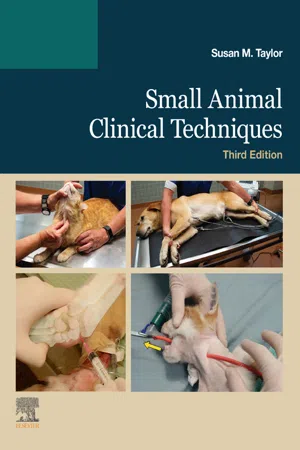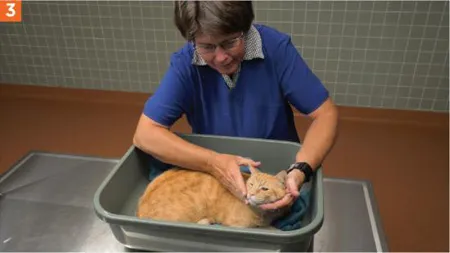
Small Animal Clinical Techniques - E-Book
Small Animal Clinical Techniques - E-Book
- 320 pages
- English
- ePUB (mobile friendly)
- Available on iOS & Android
Small Animal Clinical Techniques - E-Book
Small Animal Clinical Techniques - E-Book
About this book
**Selected for Doody's Core Titles® 2024 in Veterinary Nursing & Technology** Learn how to confidently care for small animal patients with Taylor's Small Animal Clinical Techniques, 3rd Edition. Filled with more than 60 of the most common procedures performed by veterinary technicians and assistants, this highly visual guide helps you easily master the diagnostic and therapeutic clinical techniques that are essential to small animal practice. Each procedure uses clear step-by-step instructions to walk you through the purpose, indications, contraindications and concerns, complications, special anatomy, equipment, restraint, and procedure techniques. This new edition also features a new chapter on physical examination, all-new physical examination procedure videos, and updated images throughout the text. And as with previous editions, Taylor's companion online learning modules will further hone your ability to logically think through procedures and properly perform skills.- Coverage of the most common procedures performed by veterinary technicians and assistants are covered in a clear, concise, and highly visual way.- Consistent approach includes step-by-step instructions, principles, and photographs for all procedures to show you how to think through the procedures in a logical manner and perform the skills well.- Case studies help ground you in your understanding and reinforce clinical experience.- Narrated videos located on the Evolve companion website provide visual, real-time demonstrations of clinical techniques and are a perfect review tool.- NEW! New chapter on physical examination incorporates a comprehensive step-by-step photo essay to help you easily understand how to perform common techniques.- NEW! Physical examination procedure videos on the Evolve companion website help you put techniques into practice.- NEW! Updated images throughout the text are paired with procedures to better illustrate step-by-step technique instructions.
Frequently asked questions
- Essential is ideal for learners and professionals who enjoy exploring a wide range of subjects. Access the Essential Library with 800,000+ trusted titles and best-sellers across business, personal growth, and the humanities. Includes unlimited reading time and Standard Read Aloud voice.
- Complete: Perfect for advanced learners and researchers needing full, unrestricted access. Unlock 1.4M+ books across hundreds of subjects, including academic and specialized titles. The Complete Plan also includes advanced features like Premium Read Aloud and Research Assistant.
Please note we cannot support devices running on iOS 13 and Android 7 or earlier. Learn more about using the app.
Information
Physical examination
PROCEDURE 1-1 Physical examination
Purpose
Indications
- 1. A complete physical examination should be performed on every animal presented to a veterinarian.
- 2. The physical examination is the most important skill for a clinician to develop because it can detect minor abnormalities before they become serious problems, and abnormal findings can direct further diagnostic evaluation, leading to a diagnosis.
- 3. A complete physical examination should be performed at least once a day on all animals that are hospitalized for treatment of illness or injury.
Contraindications and concerns
- 1. Familiarity with normal physical examination findings can only be achieved by practicing the technique. Identification of abnormal findings often requires recognizing subtle differences from normal.
- 2. Develop a consistent and thorough physical examination technique, avoiding the temptation to immediately focus on findings related to the presenting complaint. “More is missed by not looking than by not knowing” is a quote credited to Thomas McCrae, who was a physician and renowned medical educator in the early 1900s.
- 3. Unstable patients should have an abbreviated physical examination to assess cardiovascular, respiratory, and neurologic systems, followed by a complete physical examination once they are more stable.
- 4. Stressed or aggressive animals can be difficult to examine. Complete as much of the physical examination as possible from a distance before proceeding to a hands-on examination. Sedation may be required for a complete physical examination in some patients.
Equipment
- • Stethoscope
- • Penlight or other light source
- • A quiet room


Positioning and restraint
- 1. The animal should be standing quietly on the table or on the floor during much of the physical examination.
- 2. Having an assistant to control the animal’s head is often beneficial.
- 3. Cats seem to prefer minimal restraint and they like a place to hide. They may be most comfortable in a box with a towel, facing away from the examiner.

Special anatomy
Technique: Physical examination
- 1. The physical examination consists of general observations and hands-on examination.
- 2. A number of important steps must be included in the physical examination of all dogs and cats. Although the precise order of the ste...
Table of contents
- Cover image
- Title page
- Table of Contents
- Copyright
- Dedication
- Preface
- 1. Physical examination
- 2. Venous blood collection
- 3. Arterial blood collection
- 4. Injection techniques
- 5. Vascular access techniques
- 6. Dermatologic techniques
- 7. Ear examination
- 8. Ocular techniques
- 9. Respiratory system techniques
- 10. Cardiac techniques
- 11. Gastrointestinal system techniques
- 12. Urinary system techniques
- 13. Vaginal cytology
- 14. Bone marrow collection
- 15. Arthrocentesis
- 16. Neurologic examination
- 17. Cerebrospinal fluid collection
- 18. Tests to assess clotting
- Index